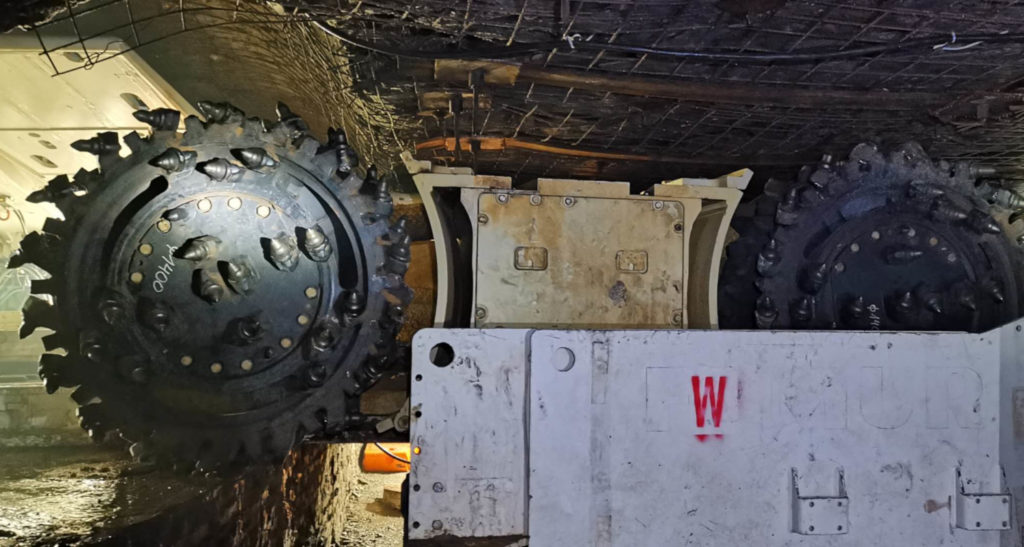There are not many truly global coal longwall technology companies but Poland’s FAMUR SA, headquartered in Katowice, is certainly one of them and has been making progress on two fronts recently. Firstly it has developed a FAMUR automated longwall system in response to increasing geological and human constraints during underground operations. Secondly, it managed to install a major thin seam Mikrus longwall system remotely in China at the height of the pandemic, despite all odds.
Autonomous longwall system development
The company said in March 2021 that implementation and multi-stage tests of its first autonomous longwall lasted almost a year and involved experts from FAMUR itself plus FAMUR Group entities FAMUR Institute, Elgór+Hansen and Elsta Elektronika. This is how an integrated system for automatic control of the FAMUR longwall system was created. It was the first project of this type carried out with full resources of companies from the FAMUR Group with the help of experts of Elsta Elektronika in Wieliczka. Its aim was to implement and test an integrated system of automatic control of the longwall system, and thus to achieve maximum automation of the longwall mining process under specified conditions. The activities carried out were a response to the expectations of customers around the world and means the company joins a select club including Komatsu Mining and Caterpillar in being able to offer this level of longwall technology.
FAMUR states: “Reliable and dependable communication between the systems in a mining complex ensures the mutual reliability of equipment operation. It also improves safety by enabling, if necessary, to withdraw operators from the zone of special mining and geological hazard. Depending on the current conditions in the mine, it is possible to apply different levels of automation – from the cycle of reinstallation (lowering, advancing, extending) of a single powered roof support unit to the conveyor, through reinstallation of the group of powered roof support units and advancing the conveyor following the mining machine, up to automation of the operation of the shearer slotting in the face (cuting).”
The heart of the system is a gateway computer located near the face. It receives data from the mining machine, the electro-hydraulic control system of the powered roof support, the armoured face conveyor, the intelligent video cameras and, optionally, from the methane emission control system. For the purposes of the project, an innovative data acquisition and archiving system was developed and applied, using modern IT technologies such as MQTT data bus and MongoDB and InfluxDB databases.
Remote monitoring of the longwall system operation is made possible by the event-oriented intelligent application for visualisation and control of the mining process. The operator has an overview of the basic process parameters and is informed by the system about potential hazards to the longwall operators and production disturbances. An important function in the system is provided video by cameras that enable detecting the presence of people in the monitored area. Through the use of hardware support for artificial intelligence mechanisms, the video cameras themselves find the human and notify the master longwall control system. The artificial intelligence algorithms applied can be trained and adapted to different observation sources, such as the clothing of the mine workers where the system is working.
The project was initiated in October 2019 and was preceded by design work. The implementation of the machines into operation and testing of the system lasted until autumn 2020 and was carried out on the premises of the FAMUR machine park. “The tests carried out on the surface have not only given us the opportunity to avoid many of the risks associated with commissioning of the longwall system in complex operating conditions. It was also an opportunity to test over a dozen of FAMUR Institute’s automation and communication projects and solutions, the implementation of which would not have been possible without conducting tests on the surface. Gained knowledge, competence and experience will allow FAMUR to strengthen its position on the Polish market, and in the long run to gain competitive advantage abroad.”
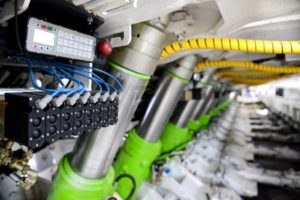
Mikrus remotely commissioned in China
A recent article by Karol Bartodziej, the Director of Electrical Segment Development at Elgór + Hansen (FAMUR Group), outlined in some depth a project to remotely implement a Mikrus low thin seam longwall complex in China. After delivery and unpacking inspection a total change of circumstances occurred – the pandemic hit. Instead of implementing the next phase, that was providing the maintenance and engineering services to commission the longwall complex delivered, FAMUR faced travel bans, and the growing epidemic threat made it virtually impossible to perform its contractual obligations as planned.
The Mikrus system is a set of machines consisting of a GUŁ cutting and loading head, face conveyor, beam stage loader, belt tail piece (boot end), power supply and control system. FAMUR sells a custom-made product so it usually needs the final parameterisation of its operation in the mine, in co-operation with suppliers of the other longwall equipment. From other suppliers the project also included powered roof support units with electro-hydraulic control system, a 3.3 kV power supply system, safety interlock system & pump station rom, but FAMUR was the integrator of the longwall complex automation and it was not possible to carry out all the work related to the control system software in Poland before shipment.
“Consequently, the direct presence of our engineering services on the first days of the machine’s operation and the presence of an experienced service technician during installation were to have a significant impact on the proper operation of the system. The situation was unusual since we had to co-ordinate our control system with Chinese suppliers providing equipment that we were dealing with for the first time ever. Moreover, the contract stipulated that correct interaction between these systems had to enable maintenance-free coal mining in the complex, which was a real challenge in itself.”
Since the contract required a compatibility test to be performed on the surface before underground operation, FAMUR and the client decided that performing this task remotely was likely to be successful. FAMUR started with hiring a team of service technicians in China to be its representatives, and under remote supervision, step by step, they began assembling the machines together. “Then, we commissioned and parameterised the control system. They were not trained how to handle the product but we needed someone available locally who would perform the necessary tasks diligently, who would be our hands and eyes in the place where remote links were not enough.”
The complications of Chinese Golden Shield internet restrictions meant the mine could only communicate with Poland over an encrypted link at speeds as low as 0.02Mb/s, with the transmission breaking every now and then. “Offered links provided the declared parameters yet in China only, and it was impossible to count on any stable transfer outside the country. On the first days of the commissioning, it seemed that we would fail with our task because of this mundane barrier.”
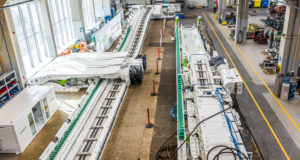
The mining client, China Energy, which is a major Chinese state-owned enterprise, arranged a link on special terms that was not to be covered by the Golden Shield internet restrictions. The FAMUR server was connected on site directly via a fibre optic cable to an international hub in Xi’an, from where the connection to Europe comes out of China. But despite the fact that, in theory, it was a link not supervised under the Golden Shield, the transfer never exceeded 0.25Mbps, although it was supposed to be 500 Mbps according to the operator’s declaration. Nevertheless, it was a success. Besides, the connection did not break and it ensured slow but stable operation. It was a defining moment in the commissioning of the complex.
“The programmer has to upload updates repeatedly while tuning the control system of longwall complexes and debug his or her code (analyse whether the code works correctly after corrections and look for possible errors). It is typically done by connecting the laptop directly to the programmable logic controller; the software update usually takes seconds, though it stretches out to minutes with such a slow transfer rate. Each interruption ruins the programmer’s work and forces him or her to start over. As such, if disconnections occurred more frequently than once every minute, the programmers’ work became impossible. This is why establishing a stable connection to Poland was a milestone in our work.”
The complex was assembled in two phases before mining began. First, surface testing and training took place from mid-March to late May 2020, followed by a second underground installation phase at the target longwall. Conducting tests on the surface is not a standard procedure, of course. “Nonetheless, due to the unusual design of the Mikrus system and the fact that the suppliers of the longwall roof support and many ancillary components, such as pumps and power stations, were Chinese, the client stipulated in the contract that a compatibility test and training must be carried out on the surface. It made it much easier for us to transfer the knowledge on how to properly assemble and operate the system to our newly-hired Chinese service technicians and the client.”
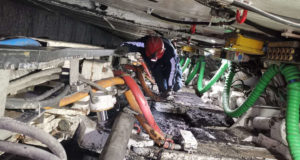
Thanks to the use of the Webex video conferencing system and the Chinese messenger WeChat, online communication was not a problem, and despite the pandemic-related constraints, FAMUR worked with the entire team including all necessary specialists to set up the system’s various components. “Ironically, sometimes this way of working actually made things easier for us, as we had better direct contact with the most experienced constructors in our company, if necessary. On-line consultation between our Chinese service staff and the design and maintenance team from Poland.”
The second installation phase – at the target longwall panel – took place in June 2020. The first cuts were made in early July so the complex began to fulfil its primary purpose. Chinese service technicians we hired were present on site throughout the entire period of the longwall system operation to make sure that it performed correctly. At the same time, a 24/7 supervision process continued at FAMUR Group headquarters to make it possible to immediately respond to any issues and provide substantive support to the Chinese service staff in analysing possible causes of downtime. “The wall was equipped with a WiFi network with Internet access, and our Chinese service team used MA-certified phones which they could use to exchange photos, videos and other information with the Service Centre in Poland.”
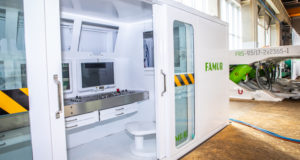
There were three system elements that had the greatest impact on the success of the automatic operation. “The first is, of course, the coordination of the movement cycle of the cutting and loading head with the operation of the electro-hydraulic system controlling the powered roof support. The second is the UPZP-1200 belt tailpiece, which automatically follows the mining progress and is part of the beam stage loader. The third element is the SmartMine visualisation and control system, which enabled not only classic supervision of the current state of the machines but also, through the analytical functions, tuning of the drive control parameters to the existing geological conditions, which is crucial for autonomous operation.”
Yet another benefit of the longwall system automation is the Mikrus system’s remarkable duty cycle. Unlike in the case of classic longwall shearer systems, the Mikrus cutting and loading head does not have to cut into the wall at an oblique angle, wasting valuable time at each end of the longwall, but it travels to the roadway instead and cuts into the face perpendicularly. “This greatly facilitates the automation of powered roof support units and saves time that would otherwise be wasted on diagonal cutting – like in the case of classic longwall shearers. When our system is working in automatic mode, the time spent by the head on the return end or the chute, during which the beam stage loader is being sumped and hoisted, is approximately 3.5 minutes, after which the next cut is made automatically. Our analyses show that most classic longwalls lose more than 20% of their working time precisely for the diagonal sumping of the shearer into the next face.”
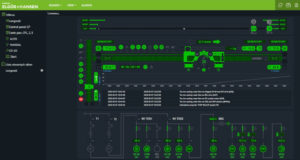
In the middle of the longwall length, miners encountered a rock overburden of above-average hardness that had not been detected by previous geological surveys. Since it was not visible from the cut galleries, it was a major surprise. “The cutting drum power in shearers used for such low longwalls is typically about 200 kW, and no more than 300 kW. However, the Mikrus system’s cutting and loading head features a 500kW motor, and as such, we have the full 500 kW power for the drum available at the moment of cutting. The control system automatically detected the increased load on the drum and slowed down the head’s feed accordingly, so that the entire rock overburden was machined in a way that limited the load on the system and ensured its safety.”
The mining on the longwall was concluded on December 6, 2020. “During its operation, the Mikrus system showed what it was made for. Not only did it allow us to work in automatic mode but it also managed to mine a bed that no other machine could have mined. This longwall has made history in Chinese mining. It was the first longwall with perpendicular machine sumping and also the first longwall to operate in fully automatic mode, including automatic hoisting of the beam stage loader. This is a special achievement also due to the fact that it was a low thickness seam wall (1.40-1.55 m). China’s mining industry is showing a great need to exploit more attractive deeper layers of high thickness seams below residual low thickness seams. At the same time, anyone who has worked in a low longwall knows how unimaginably harsh the conditions are and how important it is to minimise the number of people in the area. The Mikrus system offers the possibility of mounting an even smaller drum, with a diameter of 1.2 m, so it makes for a good response to the needs of the Chinese market.”
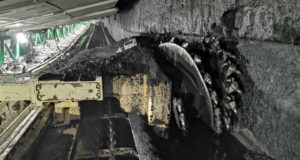
Thanks to the determination of both parties, the installation was successfully completed, both on the surface and underground. At the bottom of the mine, both the assumed daily output and automatic operation of the system were achieved.
FAMUR was only able to send a group of delegates to China at the end of November last year, and given that they had to spend a total of 28 days in quarantine, they did not arrive on site until the time of the machinery inspection. The maintenance work has already been completed and the Mikrus system is scheduled to begin operation in the next longwall in July 2021.
Bartodziej concludes: “The experience gained during this commissioning showed us how we could further enhance the remote diagnostics features so that start-ups, like the one discussed in this article, would be easier for us and our customers and could become an everyday occurrence. With this knowledge, we can confidently offer our products to foreign markets even during periods of hard lockdown or other cross-border restrictions.”











